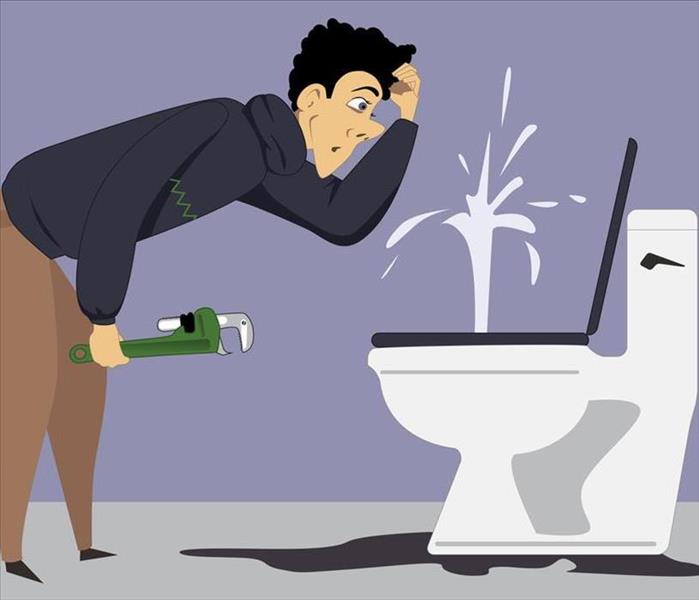Why does my toilet leak every time I flush?
11/9/2022 (Permalink)
Why Does My Toilet Leak Every Time I Flush?
You can fix most toilet leaks yourself with a little elbow grease (and maybe some plumber's putty). In this post we'll discuss why toilets leak and how to tell if you have a leaky tank or bowl.
Toilets leak for a lot of reasons.
You’re not alone. Many people have experienced a toilet leak, and it can be difficult to determine why it happens. There are many reasons that a toilet might leak, including:
- A clogged drain line
- A loose flapper or flush handle
- A leaking shut off valve on the tank
- A cracked or broken tank
1. Dry wax ring or improper installation.
If your toilet leaks every time, you flush it, you may have a leaky wax ring.
The wax ring is a rubber or PVC device that fits between the toilet bowl and the floor to prevent leaks from occurring. When properly installed and maintained, it should last for about two years before needing replacement. Leakage can often occur once the wax ring ages and or due to improper installation.
2. Tank flange can be broken or tank not tightened.
If you've tried to diagnose the leak and determined it's coming from your tank, then the problem could be that:
- Your tank flange is broken or not tightened properly. This will allow water to run down into the bowl of your toilet. The flange is a metal piece that sits between the tank and bowl, giving you a tight seal against leaks.
- Your toilet isn't level, causing one side of your toilet to be higher than another (often due to uneven flooring). If this happens, water can run out of one side when flushed since there's no longer an airtight seal around the toilet base.
- Your support is broken or not installed properly and cannot withstand heavy usage without falling apart under repeated use or shifting over time.
3. A worn out, cracked or damaged flapper, which is the most common reason for a leaking toilet tank.
The most common reason for a leaking toilet is a worn-out, cracked, or damaged flapper. The flapper is the rubber seal that keeps the water in your tank and not on your floor. Replacing it yourself takes only a few minutes and costs less than $10 at hardware stores. If you don't feel comfortable doing that yourself, you can have a plumber replace it for about $50-$100.
4. A tilted or loose toilet bowl may cause water to slowly leak from the base of the toilet and pool in the bathroom floor around the toilet.
If your toilet is leaking, either water is coming out of the base of the toilet or there is a pool of water around it. In both cases, you should check to make sure that the bowl isn't tilted or loose.
If your floor is not level, this can cause your toilet bowl to become tilted. To fix this problem, adjust the bolts connecting your toilet to its base until they're barely touching each other.
If your floor has shifted or moved over time and no longer supports your toilet securely, it could be loose and therefore prone to leaking. In this case, unclamp from under any pedestals that support it and then gently lift on all four sides until it's level again before replacing any clamps or pedestals you removed in order for them not to get lost down there somewhere!
5. Condensation on a toilet tank is another possibility if you see droplets of water underneath or on your tank lid, along with damp walls and floors around your toilet.
If you're noticing condensation on your toilet tank, it's not always a sure sign that the leak is coming from inside the toilet. Condensation can be caused by several factors:
- A leaking roof or window AC unit outside of your bathroom
- A faulty humidifier in another room that's sending moisture into your walls and flooring
- An air-conditioner is running constantly and adding humidity to the air in your house.
6. A damaged shut-off valve causing a drip at the angle stop of your toilet supply line, where it’s attached to the angle stop (wall shut off) just below the tank, which generally means that you have a slow leak in your toilet supply line.
If none of the above suggestions have resolved your leak, it could be that there is a problem with the actual shut-off valve or supply line itself. The first step to finding this out is to check for leaks in each of these components:
- Shut off valve
- Angle stop (wall shut-off) just below tank
- Supply line from shut off valve to wall and/or floor drain connection. Check for kinks in lines, cracks in PVC pipes, and breaks in copper pipes.
The good news is that most of these problems can be fixed quickly and easily. All it takes is a little know-how, some time, and patience—and maybe even a sense of humor!



 24/7 Emergency Service
24/7 Emergency Service
